Every camera is standard set to AWB, meaning "Auto White Balance". AWB uses 18% gray as a reference, to correct any color cast in the image. But the auto white balance is a dumb algorithm that cannot interpret a scenery. Perhaps it would be best to set the white balance yourself, instead of relying on the camera.
In the analogue photography you had a choice for daylight film or artificial light film, among a few others. And once you made the choice you had to stay with it during the remaining images on that film role. A lot is changed with the digital photography. Now it is possible to have a custom correction for every single photo. By choosing the auto white balance the camera will read the scenery and adjust any color deviations as much as possible, if necessary.
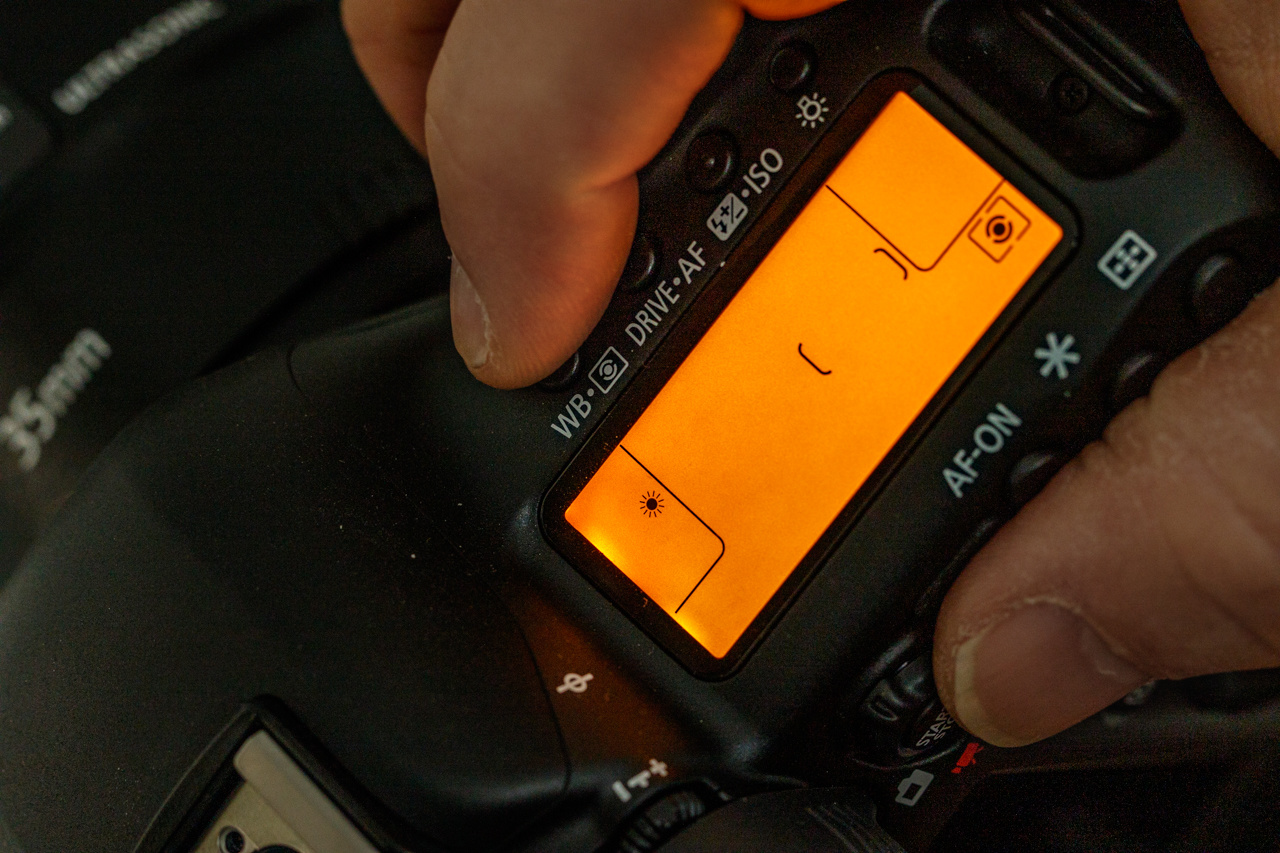
Every camera has the possibility to change the color balance from auto to a lot of presets like daylight, shade, cloudy, tungsten, fluorescent and a custom color temperature. Turning the auto white balance off gives more control.
Auto white balance will work for most images under normal, or standard situations. The setting is perfect for most people. But when a correct color is very important and critical, it might be much better to choose a fixed white balance setting. I can advise this for landscape photography. But also event photography, or wedding photography, may benefit from it.
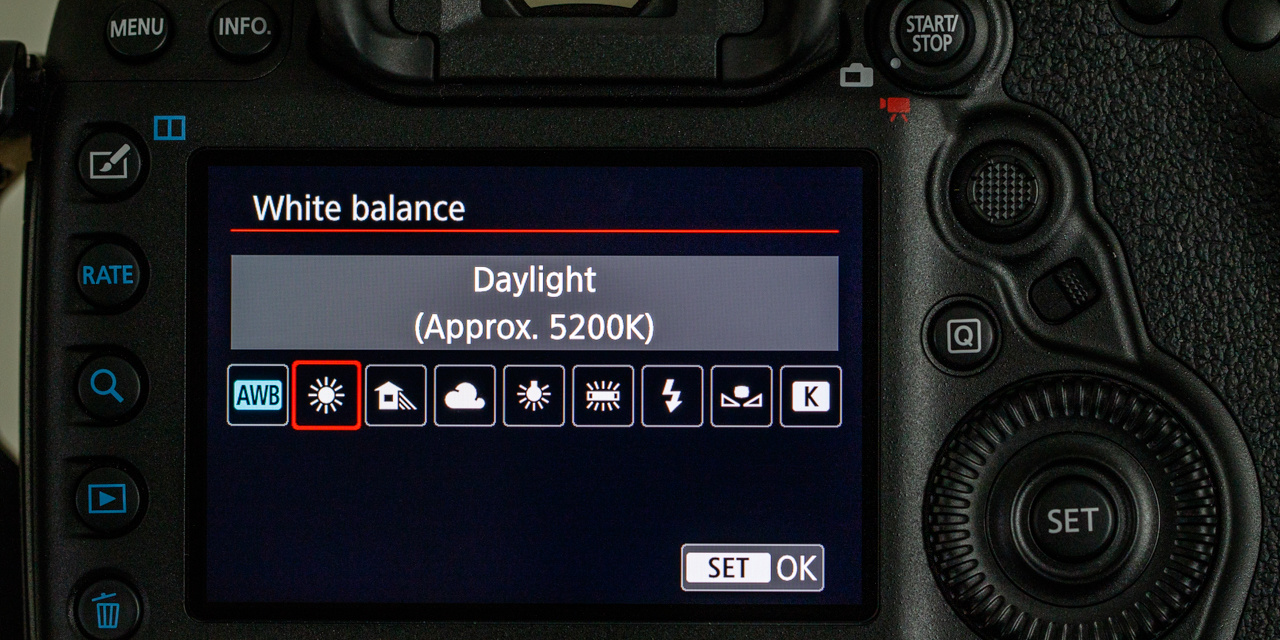
I have a strong preference for daylight setting. I feel it gives the best result, especially in landscape photography. But also with other sorts of photography can benefit from a fixed white balance.
A landscape photographer is often confronted with different light situations and changing ambient colors during the day, sunset, and twilight. Sometimes the light can be truly magical, with an intense red sky or beautiful colors reflecting in water. If your camera is set to auto white balance, the system might try to correct these extreme colors into something more neutral.
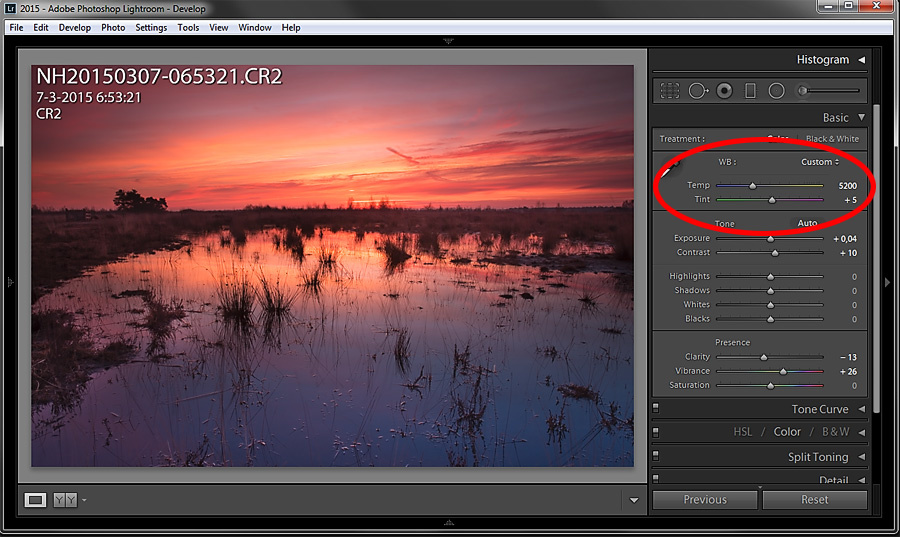
Back in 2015 I witnessed an amazing sunset with intense colors. Although I cannot check what effect the auto white balance would have given, the colors have turned out perfect with daylight setting.
When using a fixed white balance setting, you get a consistent color balance throughout a series of photos. Changes in ambient colors will be much clearer visible on screen because there is no system trying to take out any excesses in color casts. I always use daylight ("daglicht" in the images below) setting, approximately 5200K, which is imitating the daylight film from the analogue days.
To have an idea what the difference is between auto white balance and a fixed daylight setting, I shot different scenes during one single morning. I took two pictures of every scene, with the white balance set to auto and daylight. I did this at the spot, on the camera, and not afterwards in post processing. As a matter of fact, these images have no post-processing whatsoever. It is straight from the camera.




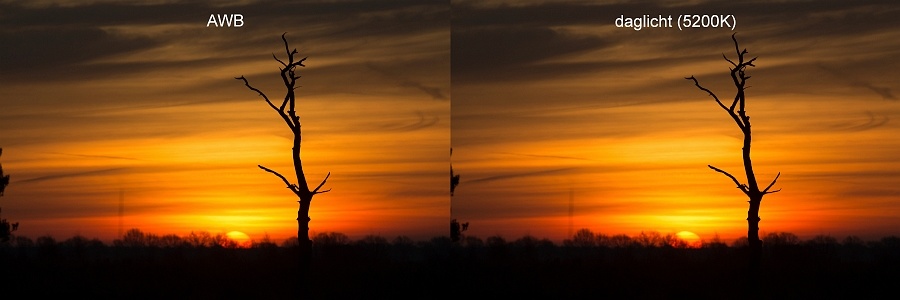

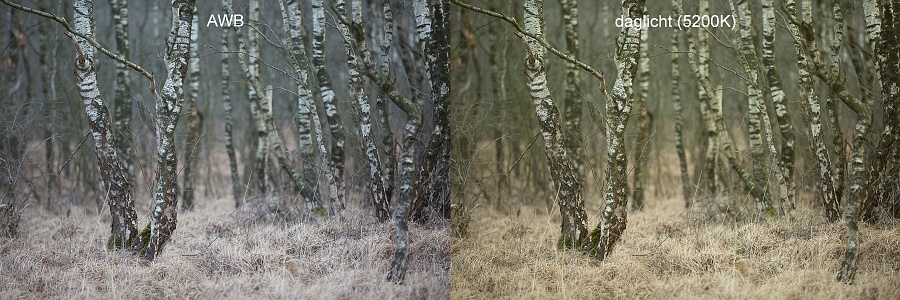
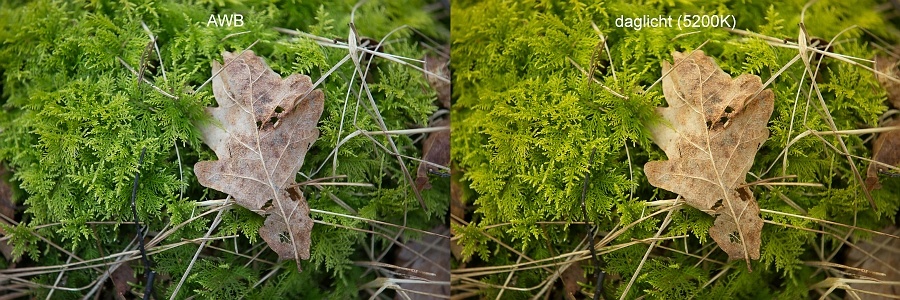


I know what some of you might think; when you shoot in raw file format, you have the ability to change white balance (or color balance) in post processing, without any degradation or loss in quality. And that is true, this camera setting can be changed without any problem. I also shoot my images in raw, of course. Nevertheless, I don’t want my camera to calculate a white balance setting for every single image I make. I want to be in control.
I have found it is much easier to judge an image on the LCD screen of my camera when there is no difference in color between images. Auto white balance will calculate and possibly set a (slight) different color temperature for every image, depending on what is in the frame and what colors are present.
Even more important, I find the difference in white balance settings to be distracting in post-processing. It takes an extra step when I need to correct all images to the same color temperature to make comparison and the selection process easier. And if you think one image needs a bit of fine tuning after all, it is always possible. That is one of the strengths of shooting raw, of course. But I prefer to judge this from a consistent color balance throughout the series of photos I have. And I think the daylight white balance setting is the best "neutral" setting available.
This also works for photographers who shoot a lot of images in a short amount of time, in a setting where the light situation doesn’t change a lot. A series of images from a wedding shoot is a perfect example; every image needs to have the same color balance. So why not using a fixed white balance? This prevents unwanted corrections by the auto white balance system, and it makes post-processing of large series of images much, much faster.

An example of a wedding shoot, in the same location. With a fixed white balance I am sure the colors in this series will be consistent. When auto white balance is set, every photo can have a different color temperature. You can correct this, but it is an extra step in post processing.
I find any variance in color temperature due to auto white balance distracting, so I have used daylight setting for many years now. Nevertheless, I do change white balance setting if necessary. For night photography I use a setting of 3400K or 4000K, depending of the amount of surrounding artificial light sources, or if moonlight is present. And a color temperature of 2700K is perfect for indoor photography, when light bulbs are the main light source. But when I go outdoors again, I change it to daylight. Should I forget to change it back, it will be visible on the screen, and because I shoot raw it is easy to correct.

A night scene from the village of Gjøgv at the Faroër Islands. I changed my white balance to 4000K (Canon EOS 5D IV EF16-35L @ 16mm | ISO1600 | f/5,6 | 30sec)
I do need to give a warning for photographers that prefer to shoot in jpeg, and don't want to use raw. When using a fixed white balance setting, make sure you are using the correct setting, because you won’t be able to change it back. You might think auto white balance is better in that case, but JPEG shooters may benefit even more from it, since the setting is fixed in the JPEG. I would advise to experiment with it, to see if it suits your photography.
I also would like to warn on how eradicate auto white balance can be. In camera it can be quite good, especially the modern cameras have a sophisticated algorithm that can "read" the scenery and anticipate. But a simple white balance slider in Lightroom has a complete different way of reading the image. So don’t think you can switch between the auto white balance in camera and Lightroom, as can be seen in the example below.
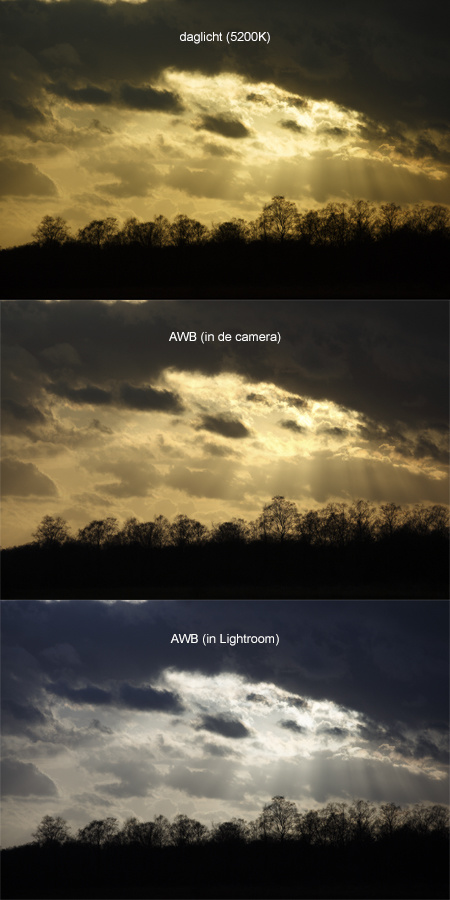
At first I thought auto white balance is the same, but as you can see, the auto white balance of the camera does a better job than the auto white balance in Lightroom. This is logical, I think. The camera was there at the spot, Lightroom just looks at the picture.
In the end it comes down to your own preferences. I guess there is no wrong or right. But you can benefit from having complete control on the color temperature of the image. What kind of white balance setting do you use? Do you choose your setting manually, or do you rely on the auto white balance? Please let me know in the comments below.
If you're passionate about taking your photography to the next level but aren't sure where to dive in, check out the Well-Rounded Photographer tutorial where you can learn eight different genres of photography in one place. If you purchase it now, or any of our other tutorials, you can save a 15% by using "ARTICLE" at checkout.
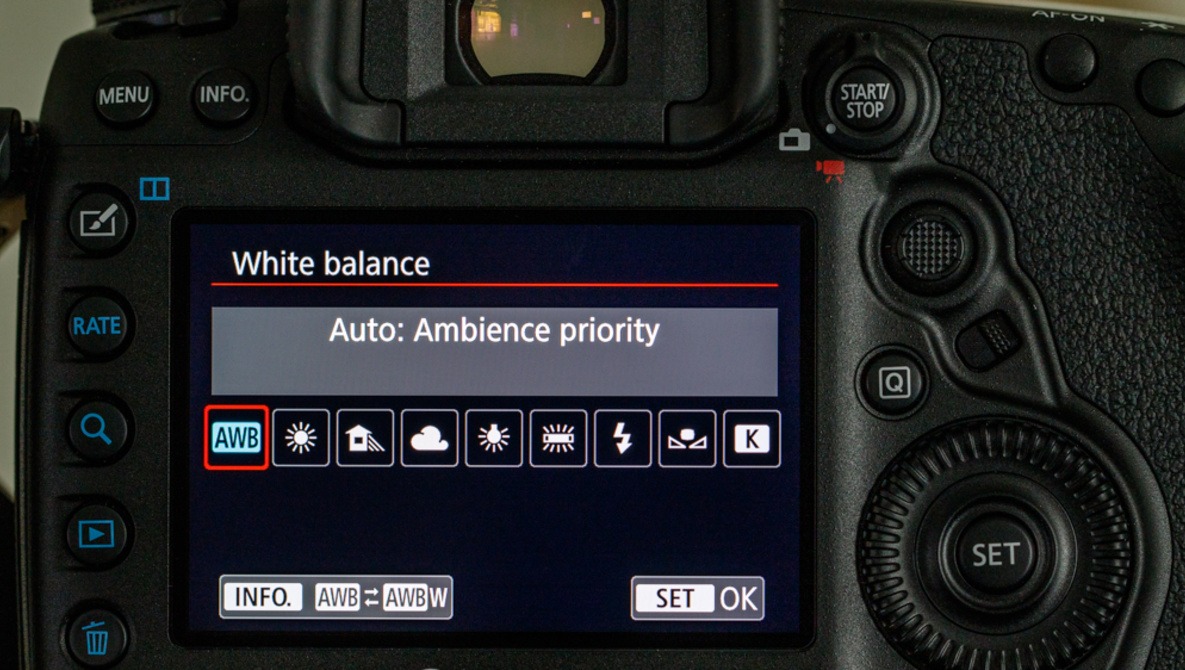






Very good article. I have used fixed WB for about 14 years. I use the cloudy setting which seems to work overall. I can then make an adjustment as necessary in Lightroom and sync the setting across (sometimes) the whole session. If the lighting varies during the shoot I just apply the settings to the appropriate images. In AWB it would take so much longer to adjust individual color settings. For the sake of production time a fixed WB is the way to go. By the way, I mostly shoot environmental portraits (high school seniors,families etc), events & weddings).
:D
In a non mixed lighting scenario like all
Of these it’s pretty easy to adjust white balance in post. It’s when you get into tricky scenes with multiple light sources or indoors with odd color casting that dialing in your WB or using a color checker on set is a time saver. Landscape is largely artistic preferences anyhow, as I actually preferred all the AWB in the examples than 5200k.
That is the beauty of photography... everyone has his own preference, which makes every photo unique
I think the biggest misconception with white balance (and one that I rarely see discussed) is the idea that white should always be white. Light has a color and in many cases you should embrace it, not cancel it out. I think this is especially true for almost any photo taken outdoors, where the environment is part of the image. One of the characteristics of the environment, at any given time, is the color temperature of the light. If a sunset is casting a heavy yellow/orange color, white will naturally appear warmer than pure white, which is to be expected. I think people look at this issue backwards a lot of times; they get this idea that white is white and something that interferes with that is “inaccurate”. But the inaccuracy is the other way around: white WILL appear to be warmer or cooler based on the ambient light temperature, and if you want to capture the atmosphere of the scene you want to embrace that concept, not avoid it. Obviously this doesn’t apply to everything but I think it’s a useful concept to keep in mind.
Regarding AWB, I find that generally speaking it does well in the middle of the spectrum (i.e. daylight) but often under-compensates at the extremes (whether it be warm or cool). But I’m sure this varies by manufacturer too.
I agree
For me, proper white balance is all about setting an ideal and consistent
baseline for your editing process. Most final images actually end up with wildly inaccurate white balance to capture a particular feel, but having a neutral canvas to work from just makes it a lot easier to achieve the look you want.
Oops. I always use AWB. There again, I don't shoot in JPG.
Does that make me a bad photographer now?
Of course not...
actually id take AWB images vs the 5200 images, anyday.
A fixed white balance most all the time. I do a lot of indoor work and bracket some shots and I want that WB to stay the same in every shot. The only time I use Auto WB is when I am doing volunteer work at my local animal shelter doing portrait work. Things at the shelter change so rapidly I want to be able to shoot quickly. So far it has worked out well (Auto WB at the shelter, I mean, not anywhere else).
Never trust anyone who starts a sentence with the word "never" :)
I shoot a lot of things that need to be pretty darn close to the correct color. Most of the time I shoot AWB and all of the time shoot RAW. Since I will be tweaking the files anyway to match the product color samples I go with AWB rather than Sunny, cloudy or shade, etc. Using LR or C1 color correcting a batch of files is pretty easy.
If you come from the film world, you may like this approach.
i shoot awb for literally everything oops
If it works for you, it is fine. As long as you get the results.
A few things:
Ⓐ Daylight is not always 5,200K. It really depends on where one is; sub-tropical, temperate, arctic? Sea level, 800m, 3,000m? Mid-day, sunrise, sunset? In Mandeville, Jamaica, at high noon, 5,200K is hardly daylight.
Ⓑ Weddings are not necessarily all the same colour temperature, either. The last wedding I did, had stage lighting at the altar, (beyond daylight), “daylight” LEDs for most of the auditorium, and “warm/soft” CFL on the wings of the auditorium & reception area. Indeed, one area was lit with the theme colours, gold & blue, using LED stage lights. Same may be true for a house party, with different lighting in each room/area.
Ⓒ I do not know about Lr, but with DarkTable, to see all images with the same colour temperature, I simply set them all to “Camera neutral.” This gives the image without any colour correction, so all images under similar light will look the same.
Ⓓ I do not know about Canon, but with Pentax, one can choose “CTE” —Colour Temperature Enhancement— white balance for scenes with a dominant colour cast such as sunsets, blue hours, bonfires, etc., for a more, “this is how I saw it,” look.
Ⓔ AWB can often be a good choice, especially if one has RGB colour metering, then spectral analysis can produce better AWB.
Ⓕ There may be another choice than just AWB. Pentax offers, “Multi Auto White Balance,” as an option. Perfect for mixed lighting scenarios.
Ⓖ Never say, “never,” and always avoid, “always.”
Well... daylight setting with Canon is often 5200K. I did notice daylight setting can be different on other cameras. I also noticed 5000K and 5050K as the standard daylight setting.
It is not about the exact number, but the be consequent throughout the series of photos, that make editing easier.
I don't understand a couple of things:
1. Why does anyone shoot in jpeg now? RAW is superior and gives greater flexibility. File sizes don't seem to be a consideration with modern large capacity memory cards.
2. How often do people *need* an image straight out of the camera? If you apply a "no editing" policy upon yourself, that's fine, but beyond that it is rare you cannot make any time for editing, especially something as trivial as WB correction.
Understanding WB is important, but I leave it at auto for the very reason that it always reminds me to check it in post. If I changed the WB all the time in the camera I might ignore it in post where I have a properly calibrated monitor. I am much more likely to nail the colours in post on said monitor than I am reviewing it on the back LCD screen of my camera.
Some people prefer jpeg above raw... even if we don't understand why, they simply do. And that also answers your second question
I was trying to understand why. "They simply do" isn't much in the way of an explanation, not that I am owed one.
You should ask them, I guess
A lot of photojournalists/ reportage shoot jpeg because they need to get their images up-line as quickly as possible - no post work.
That is why you cannot judge a photographer on the use of raw of jpeg. :)
To be clear, I wasn't judging anyone. Raw or jpeg. Auto WB or manual WB. Priority shooting modes or full manual. I don't care.
In Ansel's example, it would make more sense to use an auto WB than to manually input it.
I never suggested you did.
But I don't understand why it would make more sense to use AWB instead of manually input it....
Because in Ansel's above photojournalist/reportage example perfect WB isn't a major concern and having the camera auto adjust makes more sense in that context.
What do photojournalists say about settings? f8 and be there?
I don't agree with that, but perhaps it isn't a concern if you shoot mainly in black and white.
I used to shoot dance schools during their annual shows. I had very little time to shoot and had to sell during the break in the middle of the show. I developed a setup where I was shooting in a very controlled studio setting with perfect white balance and exposure in camera.
My camera was connected via wi-fi to a print server and images were printed 45 seconds after being taken to be available as quick as possible for selling.
There are a LOT of different businesses possible with photography and some require to deliver ultra quickly. JPEG in camera is a must in these situations.
Yours sounds like a very specific example, and I am not sure why you'd have to sell during the breaks unless it was to create a sense of scarcity for customers to boost sales, which is a perfectly legitimate business tactic.
I would imagine that your sales volume would drop off quite a bit if you sold such photos even a few hours removed from the show as it would be out of peoples' minds. If they didn't have a kiosk selling your roller coaster photos right at the exit, how many people do you think would go back onto a website and order such a photo? Capturing the customer on-location removes a huge barrier (which is getting the customer to take initiative).
Roller Coaster example isn't relevant because the set up would be completely different and probably calibrated specifically for that exact scenario.
Event photography is all about speed of delivery. Shootin JPEG in camera streamlines lots of things for that.
Lots of people shoot RAW+JPEG since there are numerous professional instances in which time is an important factor. Particularly in today's society, where you have images and videos being shared in real-time, you often need to be able to reasonably keep pace.
There are also instances in which JPEG's exported from RAW files are not accepted either, in which case you're forced to submit SOOC JPEG files.
Never thought of not accepting JPEG from RAW.
But I wonder, if people that shoot JPEG + RAW, what they will use for their final picture. The JPEG because it is easy, straight from cam, or RAW because they want post processing. Then why shoot both?
Some news organizations will not accept photos unless they are SOOC JPEG. Many times the photographer will submit that, but keep the RAW for publishing later or in less stringent places.
Ah yes. Now I understand. Thanks
I used to shoot quite a bit for the newspaper on extremely short deadlines, and they needed jpegs that were downscaled for quick loading on the web. I shot in medium Jpeg + Raw, quickly pulled my selects from the Jpegs and sent them to make deadline. If they needed something for the front page, or there was an image I liked for my portfolio, I had the Raw to use, but I rarely ever needed anything but the Jpeg. Last month I shot a 5K for a local company and had to turn over Jpegs a half hour after the race so same deal, shot in Jpeg, culled through photo mechanic and turned in the shots. In both cases I set the WB manually because I don't have time to go back and tweak inconsistencies in the photos.
I see the point of shooting raw+jpeg. Very clear story. Thanks for sharing. And a good example of the benefit of shooting at a fixed WB setting.
Shoot RAW and use the any WB in camera…
LCD screens (and EVF for that matter) are not usable for checking color, or exposure. The histogram can help you with determine exposure, but for color it is simply impossible. I think LCD screens are good for a quick check on histogram and composition, nothing more, nothing less
Keeping in mind that I'm mostly a people photographer, since I shoot in raw, I usually treat every photo as its own entity; editing it the way I want it to be.That means that initial WB is mostly meaningless to me.
Often times, though, I want a consistent baseline from which to start. If that's the case then I shoot a WB patch on an X-Rite Color Checker, and then sample it in post and sync it to all the images in that particular shoot.
To keep things simple I almost always shoot AWB.
I presume you do studio work when using a color checker? I think for that sort of photography it is a very precise way for color balance. But it would be foolish to run around with a color checker during weddings, or in landscape photography. If you did, it would kill all the nice ambient light :)
There is not one way for everything. All sorts of photography ask for its own approach
Of course there's no "one way."
Even in some non studio invironments, a WB patch can be useful. Outdoor portraits, for example.
I've done run and gun type of event shoots in which I'll shoot a WB patch and use it across all the shots. That doesn't work as well if I'm, say, bouncing a camera mounted flash and mixing it with ambient. But if I'm in a position to use all ambient, it works well; especially if I'm in a room that's lit by a single type of light; typically fluorescent, or windows.
In outdoors event shooting, the same thing. Just shoot the one WB shot and use it. You don't need to run around with it.
As far as landscape work, I'm not a landscape photographer, but I don't see how using a WB patch would kill the nice ambient light. Wouldn't it simply provide a consistent baseline? Assuming one is shooting raw, that is.
I have an X-Rite Colorchecker and a Whibal Reference card in my bag at all times. It's not that difficult to take some baseline measurements in each major location that you're going to be in. There's obviously little point in using it if you're up against blue and purple LED lights on a dancefloor (I usually just default to 5500K in that instance), but in more standard lighting scenarios, it'll give you a tool to get closer in post than some in-camera WB preset will.
I think that the biggest reason to try to get your WB right in-camera, however, is that your histogram read-out will depend on your baked-in JPEG preview so without being at least somewhat close, you risk screwing your exposure by when the values in each channel shift with the WB in post.
Indeed. In camera settings can influence the histogram. That is why I turned down contrast in the camera.
I've joined AWB Anon. My name is Rod and I shoot AWB JPEG.
wish they have a independent Kelvin control on canon instead of having to go to the menu to change the kelvin.
maybe they do but i haven't figured it out yet.
The newer Canon camera's have the Q button, where you can acces WB on a very quick way.
Good to know I've been using the right settings. :)